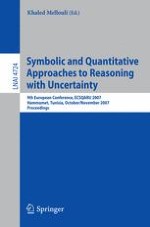2007 | Buch
Symbolic and Quantitative Approaches to Reasoning with Uncertainty
9th European Conference, ECSQARU 2007, Hammamet, Tunisia, October 31 - November 2, 2007. Proceedings
herausgegeben von: Khaled Mellouli
Verlag: Springer Berlin Heidelberg
Buchreihe : Lecture Notes in Computer Science
